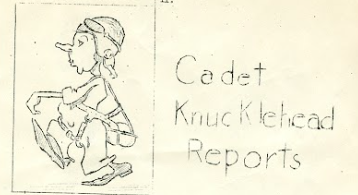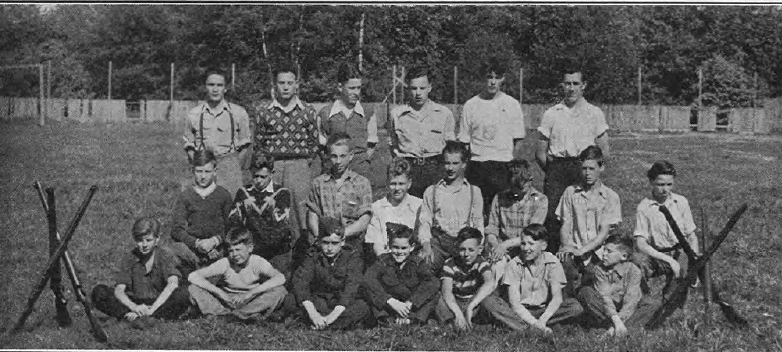Overview: This page outlines how the Mission B.C. teenagers participated in the Air Cadets and the goal to help Canadian World War Two initiatives.
The cadet corporation existed in Canada for many years. As mentioned in the 1945-1946 Mission High School yearbook:
“Cadet corps in Canada are not a thing of the last few years, for the first Corps was formed at Bishop’s College, Lennoxville, Quebec, in 1861, with another following it at Trinity College in Toronto shortly afterwards. This was the beginning of the cadet movement in Canada, which has grown until today there are over 100,000 Army Cadets, while many thousands more belong to the Sea and Air Cadets.”[1]
1945-1946 Yearbook
The group’s primary roles were:
-Discipline,
-citizenship.
The cadet corporation is military in nature, but the ultimate goal is to develop the cadet physically, mentally, and morally.[2]
In the Mission community, they were a cadet group called Cadet Corp Capers (Cadet Knuckleheads).

The cadet club was designed for the boys of the school, who got training in shooting and got small arms.[3]
The club although had some drawbacks:
The great difficulty was the lack of time, as many boys have to leave on early buses. However, some good shots are being developed and revelry is keen.”
[3] Peter Albee fonds Newsletters, News and Views, Volume V, No. 4.
Another objective that the club in Mission incorporated was the preparation of an NCO class whose goal was:
An N.C.O.’s class will be held in the gymnasium every Wednesday eighth period. The object is to instruct N.C.O.’s in the method of demonstrating manoeuvres.” [4]
Peter Albee fonds Newsletters, News and Views, Volume V, No. 1.
As shown below the role of an NCO in World War Two was fully defined as
“The Army began using non-commissioned officers who were on active duty prior to the war as the primary trainers for troops destined for overseas duty. NCOs also, for the first time, found themselves able to apply for transfers to new branches, as the creation of the Paratroopers and Paragliders offered new career opportunities. These new branches offered more pay and new challenges for NCOs looking to advance their career. These new branches, along with the massive mobilization, would increase the number of NCOs at a faster rate than ever in history. In 1941, the amount of NCOs in the enlisted ranks was 20 percent; that number would grow to 50 percent by then end of the war in 1945. With the vast amount of casualties suffered in the war, enlisted men rose through the ranks very quickly during World War II. This resulted in a perceived lessening of the prestige of the NCO to some higher enlisted NCOs who obtained their rank prior to the war. Soldiers were quickly promoted from private to corporal; and corporal to sergeant after only serving a small amount of time in the unit. The NCO also saw changes in the field, where in the infantry, the corporal was officially replaced as the squad leader by sergeants, and the infantry squad also grew from eight men to 12.”[5]
“Army NCO history (Part 6): World War II” US Army, Jarod Perkioniemi,accessed March 16, 2023.
We can see how vital the NCO club is to prepare the Mission High School students for life during the war. If the students got practical training prior, they were able to develop their skills.
It was also depicted in the 1945-1946 yearbook that a change occurred: The Mission High School cadets were now operated voluntarily. The club got off to a good start despite the reduced number of students. There was also the addition of special classes such as First Aid, Semaphore, Morse Code, Knots and Splices, and Rifle training. The students also partook in the Dominion Rifle competition. [6] We can remark that the yearbook was from the year after the war ended, so perhaps there was less of a need for students to feel they must join the armed forces.
There was the presence of the Girls Cadets, a compulsory school activity meaning all the girls had to participate in this club. The club was run by the NCOs of the year prior, who were chosen as the club’s officers. The NCOs had to undergo a month of intensive training. The goal of the club outlined by the Major was to focus on company drills. It also noted that the year prior, the girls were given no training in the military drill last year, yet they executed it very well. Gender differentiation was present in their uniforms.[7]
The girls are “not to wear hair ribbons or bright nail polish and there must be absolutely no gum-chewing. Their uniforms consist of dark skirts and white blouses with navy quiff caps, black ties, white socks, and brown shoes.”[8]
Peter Albee fonds Newsletters, News and Views, Volume 7, No. 1.
We can see the difference between the girls wearing skirts and being controlled by the boys. On the contrary, the boys would wear long pants and be controlled by fellow men. We could hypothesize that the girls were training to join the air force, one of the roles women were permitted to do.

We can see in the image above that the boys uniform consisted of long pants, and that the teacher was also a fellow male.
The goals of the Air Cadet program across Canada was stated as follows:
“Canada like Britain and the other Dominions had Army and Navy cadet forces, a sort of junior officer training program for teenagers. There were no comparable air force program, although some Army Cadet Corps were informally affiliated with RCAF Air Reserve squadrons. The shortage of pilots at the onset if the war prompted efforts to set of an air force cadet program. Air Minister Power directed that a nation-wide voluntary organization be formed to sponsor and develop and prepare youth for pilot training and other service with the RCAF. [Air Cadet League] The boys of course were primarily interested in becoming pilots. An Order-in-Council was passed establishing the Air Cadet League of Canada to work with the RCAF (November 11, 1940).
“Canadian World War II Air War: Air Cadets
We can see that the air cadets’ efforts directly affected the recruitment of pilots. In conclusion, we can see how the cadet club in Mission High School directly prepared its female and male students to join the military and potentially join in the war effort.
Sources
[1] James Musgraves fonds, 1945-1946 Mission High School Yearbook, accessed March 16, 2023. Mission Community Archives.
[2] James Musgraves fonds, 1945-1946 Mission High School Yearbook, accessed March 16, 2023. Mission Community Archives.
[3] Peter Albee fonds Newsletters, News and Views, Volume V, No. 4. accessed March 16, 2023.
[4] Peter Albee fonds Newsletters, News and Views, Volume V, No. 1. accessed March 16, 2023.
[5] “Army NCO history (Part 6): World War II” US Army, Jarod Perkioniemi,accessed March 16, 2023.
[6] James Musgraves fonds, 1945-1946 Mission High School Yearbook, accessed March 16, 2023. Mission Community Archives.
[7] Peter Albee fonds Newsletters, News and Views, Volume 7, No. 1. accessed March 16, 2023.
[8] Peter Albee fonds Newsletters, News and Views, Volume 7, No. 1. accessed March 16, 2023.
[9] “Canadian World War II Air War: Air Cadets” Children in History, accessed March 16, 2023.https://histclo.com/essay/war/ww2/cou/can/air/w2ca-cad.html